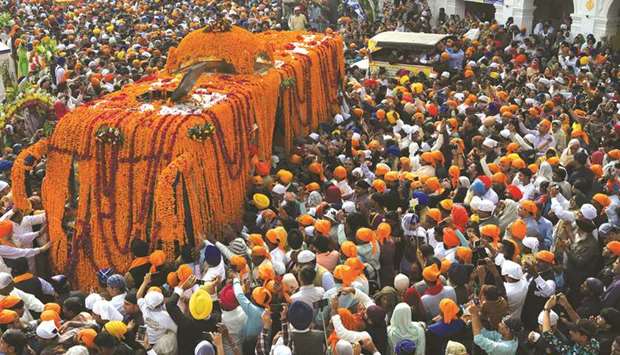It is one of the biggest birthday celebrations in the world: millions of Sikhs mark yesterday the 550th birth anniversary of the founder of their religion, the Guru Nanak.
The annual celebration has been given extra significance this year with the opening of the Kartarpur Corridor, a secure, visa-free passage between arch-rivals India and Pakistan that gives Indian Sikhs access to the place where the guru died in 1539, now one of the religion’s holiest sites.
Interior Minister Ejaz Shah joined large numbers of Sikh religion followers from world over for the ceremony.
Addressing ceremony, the minister said that Kartarpur Corridor is a great gift from the Pakistan Tehreek-e-Insaf (PTI) government to the Sikh community, paving the way for peace and friendship in region.
He said that Pakistan will continue to look after holy places of minorities, including that of the Sikh community.
Addressing the ceremony, Punjab Governor Chaudhry Mohamed Sarwar said that the PTI government is committed to protect religious heritage of minorities in country.
He said that the Pakistani people have opened their hearts for Kartarpur Corridor project.
Meanwhile, Punjab Chief Minister Usman Buzdar, in his message on the occasion, said that opening of the Kartarpur Corridor has rejuvenated the joys of Sikh community and it is another historic step by the PTI government to promote religious harmony.
Sikhism is a monotheistic religion born in the 15th-century in Punjab – meaning the land of five rivers, a region spanning parts of what is now India and Pakistan.
Five and a half centuries later, Sikhs number up to 30mn worldwide, with a rich diaspora in places such as Canada, the US and Europe – although the vast majority remain in India.
Guru Nanak was born in 1469 to a Hindu family at Nankana Sahib, a city about 80km (50 miles) from Lahore.
As he grew older the Guru began travelling, preaching a faith based on equality and one God.
He died in 1539 in the Punjabi town of Kartarpur, in modern-day Pakistan, where his remains are buried.
Nine gurus followed Guru Nanak and there is no living human successor, but the Guru Granth Sahib – the Sikh holy book – is considered the 11th and eternal.
Sikhs around the world, but especially on the subcontinent, come together to sing, pray, eat and hold sprawling processions to different gurdwaras.
In Pakistan, thousands of Sikhs marked the occasion at Nankana Sahib and Kartarpur.
Apart from it being the 550th anniversary, this year also saw the opening of the Kartarpur Corridor – a secure land link allowing Indian Sikhs to visit the Gurdwara in the Pakistani town where the Guru died.
The Gurdwara at Kartarpur is so close to the India-Pakistan frontier that its white dome and four cupolas can be seen from across the border.
However, the perennial enmity between the South Asian nations, arch-enemies since Pakistan was carved out of colonial India at independence from Britain in 1947, has meant that for decades Indians could not visit – at least, not easily.
Many had likened it to Muslims being able to see Makkah or Madinah, but not able to visit.
India has long been asking for Sikhs to be given access to Kartarpur, and last weekend their wish was finally granted with the opening of the corridor just days ahead of the birthday celebrations.

Pilgrims gather yesterday around the Palki Sahib on the 550th birth anniversary of Guru Nanak Dev, in Nankana Sahib.
